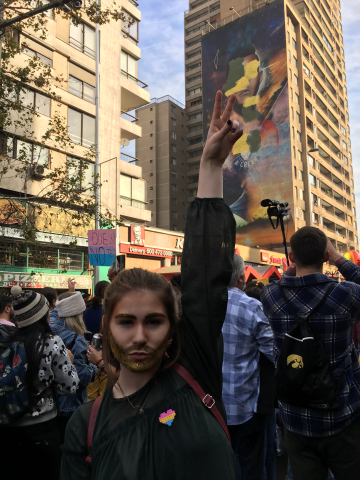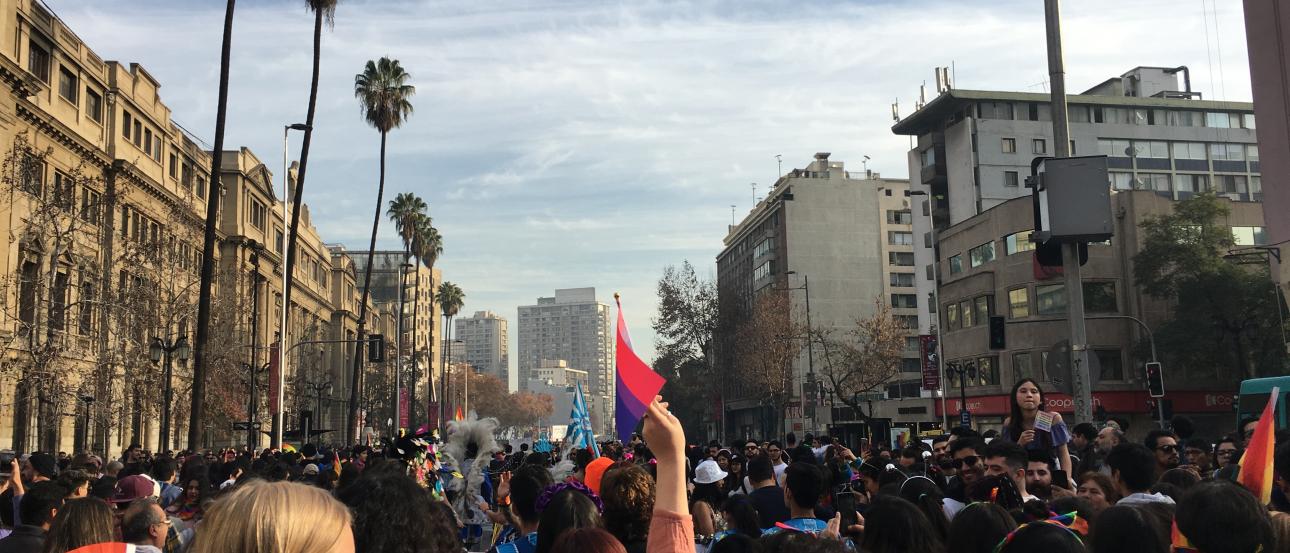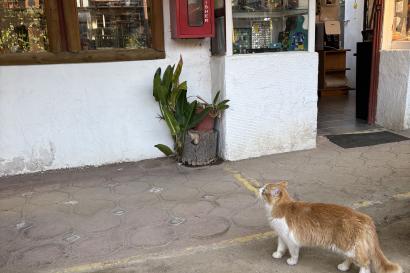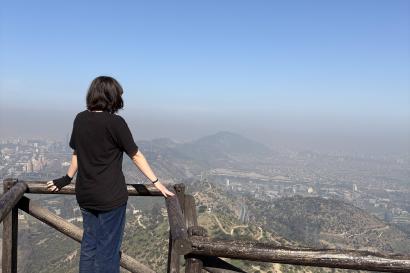I’ve attended two Prides in the U.S. since coming out as a pansexual woman. Now, I’m marching for LGBT+ equality in the streets of Santiago…with a glitter beard glued to my face.
The March going down Avenue Libertador O'Higgins
I have always felt comfortable in my identity as a woman, and I officially realized I was pansexual in 2015 while studying abroad in Wales. However, I also cross-dressed all the time growing up, and it’s a habit that’s followed me into adulthood now as well. For me, men’s clothes were just more comfortable, especially during puberty. There was always an unexplainable allure to presenting as masculine, and drag has helped me "tap into" this side of myself. When I was a kid, I would put shaving cream on my face and pretend to shave my imaginary stubble with my dad in the morning before church. When I got older, my dad taught me how to tie a tie for church when I wanted to wear slacks and a blazer instead of a skirt. Despite my parents’ conservative views, they’ve never reprimanded me for wanting to dress "like a man" at times, for which I’ve always been grateful.

Me debuting my baby drag persona, with a heart-shaped pansexual pin
I didn’t ever think being a drag king was something I could do until I got to college and started doing drag makeup secretly in my dorm, then in my apartment. I would send drag selfies to my friends to critique the look, but never intended to go out.
That is, until now.
Here in Santiago, drag performers refer to themselves as transformistas.The culture of drag is a bit different than in the U.S.; while the north sees the hobby and identity as a performance, transformistas see the act of gender-fluid dressing as less of a performance and more of a political statement against the rising conservatism in Chile’s government. It’s an assertion of freedom to go beyond the gender binary and to unapologetically be oneself.
Homosexual couples have had legal protections in Chile since 2015, and a recent amendment to the adoption process here prohibits preferentiality of heterosexual couples over homosexual couples, except in the case the child expresses the desire to have both a mother and father.
However, gay marriage remains illegal in Chile. In 2014, an anti-discrimination law was passed that makes it illegal to harass an individual based on their gender representation or sexuality. There are notices in almost every metro station in downtown Santiago with the emergency number to call if you’ve experienced assault due to your sexuality or gender. The Chilean Military welcomes transsexual and LGBT individuals into its ranks, and as of 2015, conversion therapy has been universally rejected throughout the country.

June, being the internationally-recognized month of Gay Pride, or Orgullo Gay, is a big deal in Santiago. If there’s one thing Chile knows how to do, it’s how to hold a pride parade. A float filled with transformistas led the parade downtown while the queens screamed from the mics, “If you don’t have supportive family, we’re your mothers now,” and “It’s illegal to be straight today,” in Spanish. In total, over 130,000 people took to the streets of Santiago on June 22nd to celebrate diversity in sexuality and gender representation. In the U.S., watching the elaborate floats in the parade and catching beads flung from the moving vehicles is a big part of the experience. In Santiago, the parade was more of a march of the entire group of attendees parading down the street with dancers and transformistas for dozens of blocks.

The transformistas leading the parade at the starting point in Baquedano square
In the parade, the Fundacion Iguales carried a fence frame outlining 43 cubic meters in what is referred to as the "43 cubed meters of respect" for the 43 LGBT+ fatalities suffered in Chile. They carried the frame throughout the entire duration of the march.

ariel shot of the 43 meters of respect, source: iguales.cl
Overall, the biggest difference between Pride in Chile and Pride in the U.S. is the branding of Pride in North America. In Santiago, there were a few brand representatives awkwardly standing around, but for the most part, the vendors selling Pride-themed merch were individuals, teenagers, and side-hustlers selling homemade pins and bandanas. Local dance groups did performances in Plaza Baquedano, and youth groups dressed in scout uniforms performed routines for the crowds as well. Some heteronormative aspects still permeated the atmosphere; there was a Pride ‘king’ and ‘queen’, but they were dressed in more carnival-type costumes than Pride-themed, and they weren’t drag. My thoughts are that the carnival-esque aspects of the march came from more of a Latin flair than a Pride flair.
A lot of people asked to take photos of or with me, and I thoroughly enjoyed the attention after standing in front of a mirror two hours that morning gluing glitter to my jawline and re-shaping my facial bone structure with bronzer I had bought from the supermarket the night before. The sad fact is that the Chilean government still has a way to go to ensure true equality of its LGBT+ citizens, but for one colorful afternoon, everyone was equal.

'Juntos Nos Levantamos' - 'Together We Rise'

Rebecca Carey
<p>Rebecca Carey has been an avid literature and science fiction fan since reading her father’s copy of Ron Hubbard’s “Battlefield Earth” as a child. She has been writing professionally for two years and has published prose, poetry, and short fiction in the University of Iowa’s undergraduate literary reviews ‘InkLit,’ ‘Witness,’ and ‘Peripheral’ in 2018 and 2019, and has published poetry translations in the University of Iowa’s undergraduate translation Journal ‘Boundless’ in 2019. She is a Creative Writing and Translation student at the Univerisity of Iowa hoping to pursue a Master’s degree in translation studies after graduation. When she isn’t buried in a book, she’s usually somewhere in between the realm of overthinking, daydreaming, and wishing she was born 500 years in the future so she could have lived on Mars. Favorite novels of hers include Trenton Lee Stwart’s “The Mysterious Benedict Society,” Jeff Vandermeer’s “Annihilation,” and William Burrough’s “Naked Lunch.” Some of her favorite Chilean authors are Lina Meruane, Roberto Balaño, and Pablo Neruda.</p>








